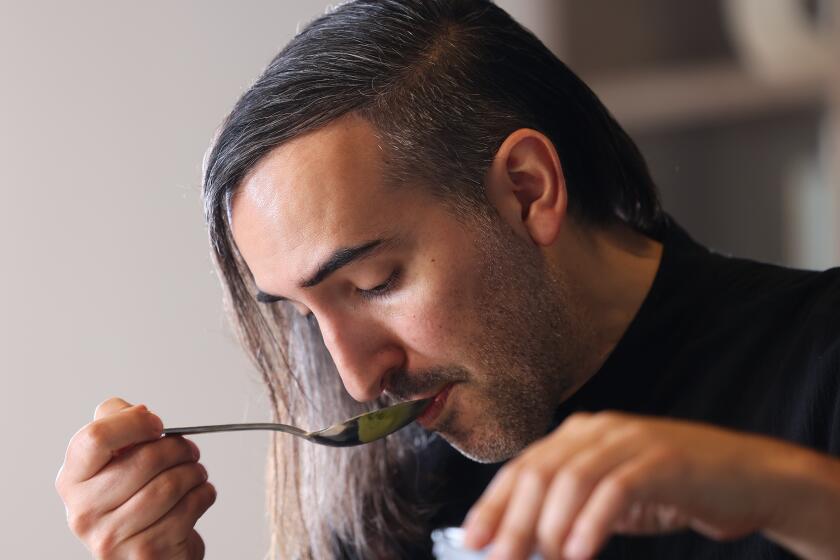The price we pay for eating healthful foods
Intestinal gas is a fact of life. We all produce it to some degree, and most people think they produce too much. But in fact, unless it’s excessive, gas production is a sign of a well-functioning digestive tract and healthful diet.
Certain foods, such as beans or Brussels sprouts, have a reputation for causing gas, but, in reality, any carbohydrate-containing food is potentially “flatu- logenic,” to use the technical term. Fruits, vegetables, grain products and legumes all contain the gas-causing culprits -- a variety of short-chain carbohydrates known as oligosaccharides, some of which escape complete digestion as they pass into the lower intestine.
Maltodextrins and cellodextrins, for example, are oligosaccharides that result from the incomplete breakdown of starches and fibers in fruits, vegetables and grains.
Raffinose, stachyose and melibiose are other oligosaccharides found in beans, peas and vegetables in the cabbage family. These carbohydrates require a particular enzyme -- alpha-galactosidase -- to assist in their digestion. Our bodies don’t manufacture this enzyme.
We do make another enzyme, amylase, required for starch breakdown, but amylase inhibitors that are naturally present in beans can interfere.
In total, about 10% to 30% of the starches we consume escape the normal digestive process. Then the gas-making begins. Once the carbohydrates reach the large intestine, the bacteria that live there take over -- feasting on the leftover sugars and small starches coming their way and releasing hydrogen and carbon dioxide gases.
Most of the hydrogen gas formed in our intestines is consumed by other gas-guzzling bacteria -- leading to the production of methane and sulfur-rich gases. The downside: These are the gases responsible for most of the odor. The plus side: Without that chemical conversion, we’d have a lot more gas than the quart or so the average human being produces every day.
Thanks to this several-trillion-strong bacterial army, we release gas about 15 to 20 times a day. The amount we release each time is about the same, so when we feel exceptionally gassy we just expel more frequently. We also produce more gas after meals, and much less during sleep than during the daytime.
There is a shortage of scientific studies on the subject. It appears, however, that not everyone gets gas from the same foods, and that eliminating the usual suspects will not reduce gas in everyone.
A case study of a particularly gassy individual, published nearly 30 years ago, was meticulous enough to determine the association between one man’s diet and his gas. The patient kept comprehensive records of all foods consumed and gas passed, creating a personal “flatulograph.” In his case, the biggest offenders were beans, Brussels sprouts and prune juice: no surprises there. But this individual also suffered terribly when he ate bananas and bagels, foodstuffs that aren’t usually considered suspect.
Physicians and dietitians may recommend that people introduce new fibers to the diet slowly, on the assumption that the composition of the intestinal flora will adjust -- resulting in reduced gas production, or an increase in the number of gas-chomping bacteria -- but studies are scarce and inconclusive on this matter.
Perhaps our systems do adjust. Or maybe we just get used to the gas and live with it.
There are a few things to consider if gas bothers you. Since many of the fermentable carbohydrates are found in fruits, vegetables, beans and whole grains -- foods that are key parts of a healthy diet -- staying away from these items should not be the first line of defense.
Instead, when preparing beans, get into the habit of soaking them and then cooking them in fresh water. This has been shown to significantly reduce the amount of some of these tough-to-digest carbohydrates, with no negative effects on the nutritional value of the beans.
Over-the-counter alpha-galactosidase enzyme supplements can also be taken with problem foods to help in digestion.
Other possible offenders that could easily be eliminated from the diet are sugar alcohols -- such as sorbitol, mannitol or xylitol -- found in sugar-free foods and candy. These sugars aren’t digested in our small intestines, providing fuel for the gas-making bacteria in our bowels.
The natural fruit sugar, fructose, is generally not consumed in large enough quantities from fresh foods to cause a problem. But ingestion of high concentrations-- from, for example, soft drinks and candies laden with high-fructose corn syrup -- could also make you gassy. So eliminating these foods may help (and also increase the nutritional value of your diet).
Because people respond differently, trial and error is the best approach. But also consider this: Since many of the gas-promoting culprits in our foods are healthful, we may need to think about what “gas price” we’re willing to pay, in the form of short-term discomfort, in exchange for long-term health benefits.
*
Susan Bowerman is a registered dietitian and assistant director of the UCLA Center for Human Nutrition.
More to Read
Eat your way across L.A.
Get our weekly Tasting Notes newsletter for reviews, news and more.
You may occasionally receive promotional content from the Los Angeles Times.










